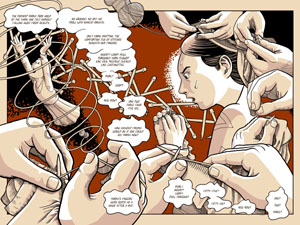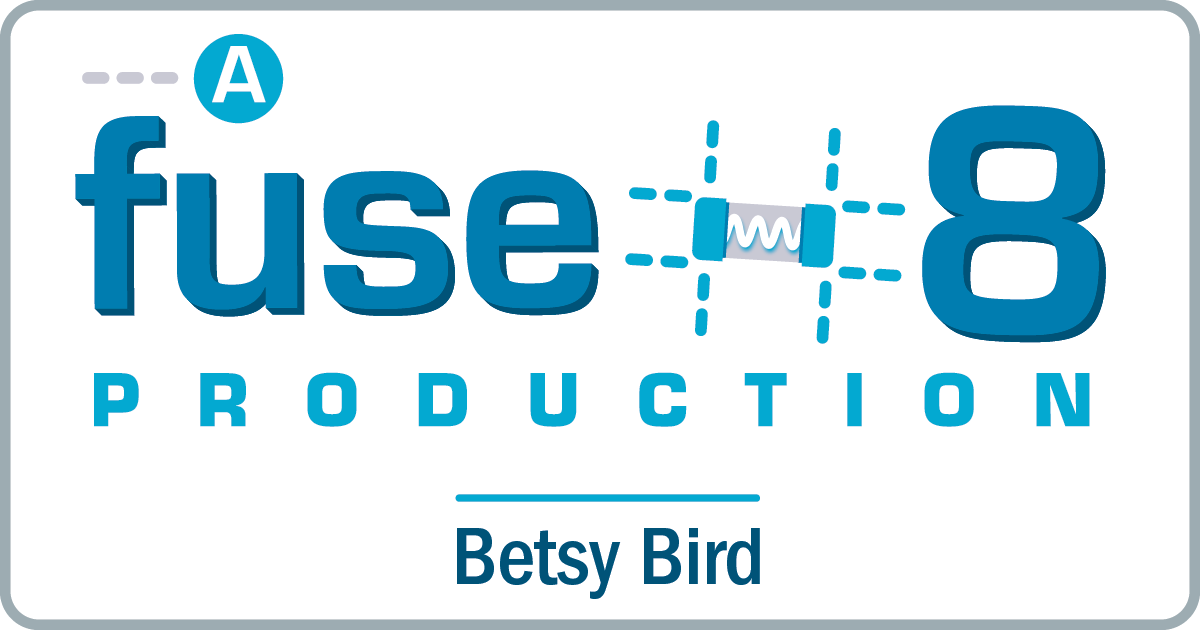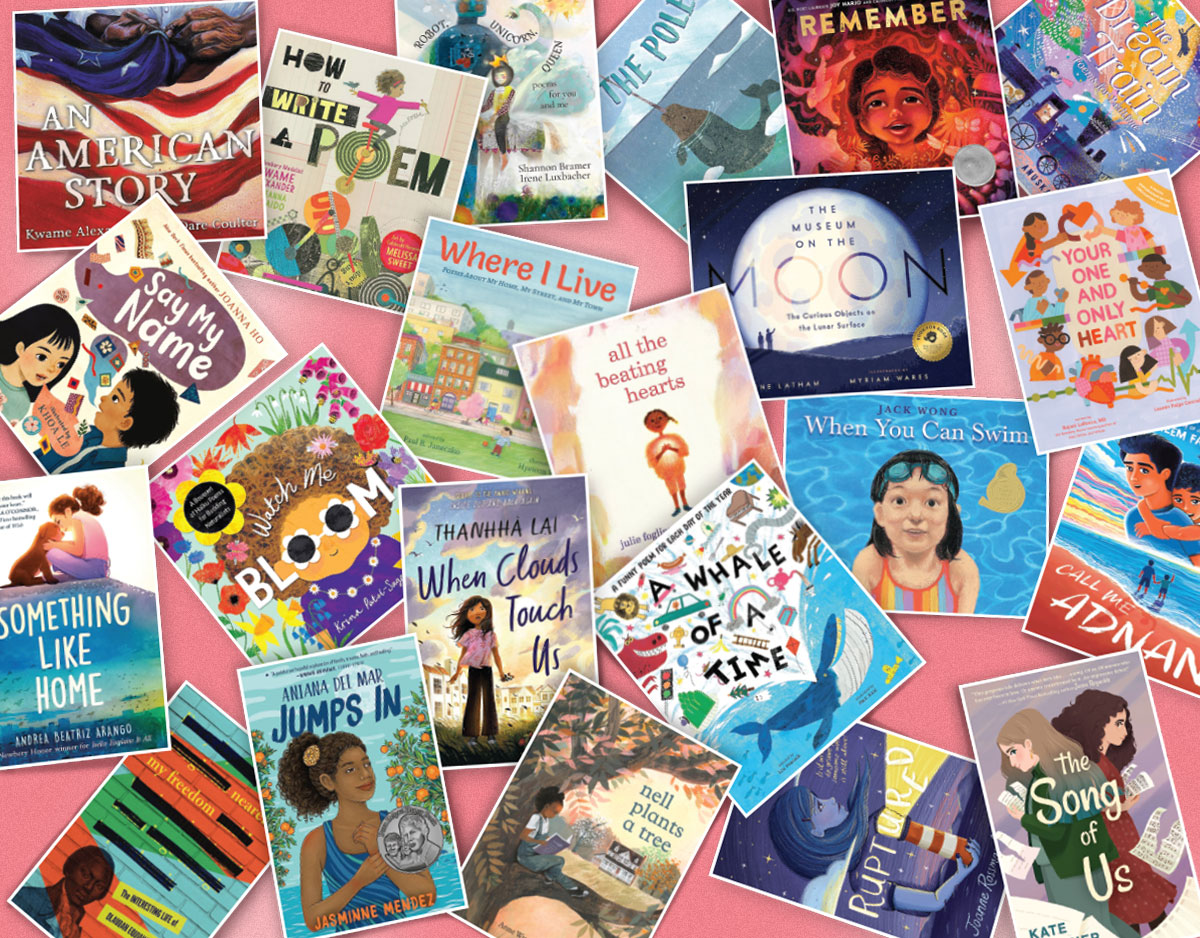Review of the Day – Hereville: How Mirka Got Her Sword by Barry Deutsch
 Hereville: How Mirka Got Her Sword
Hereville: How Mirka Got Her Sword
By Barry Deutsch
Amulet Books (an imprint of Abrams)
$15.95
ISBN: 978-0-8109-8422-6
Ages 9-12
On shelves November 1, 2010
“Yet another troll-fighting 11-year-old Orthodox Jewish girl,” says the byline. Well seriously. How was I supposed to pass that up? I’d grabbed a copy of Hereville at an American Library Association conference along with a whole host of other books. I don’t think I even gave it half a glance at the time. Just nabbed, stuffed, and scooted. It was only back in the comfort of my hotel room as I repacked my bags that the byline got my attention. I sat down for a quick look. Twenty minutes later I was still reading, with no intention at all of repacking anything until I was done. In my experience, fantasy novels for children do not like to involve religion in any way, shape, or form. And children’s graphic novels? Puh-leeze. You’re as likely to find a copy of Babymouse wax rhapsodic on the topic of organized religion as you are a copy of Harry Potter. So to read Barry Deutsch’s book is to experience a mild marvel. There is religion, fantasy, knitting, some of the best art I’ve seen since The Secret Science Alliance, and a story that actually makes you sit up and feel something. This is like nothing I’ve ever encountered before, and I think it’s truly remarkable. Without a doubt, this is the best graphic novel of 2010 for kids. Bar none.
Mirka has a dream, but it’s not the kind of thing that gets a lot of support. More than anything else in the entire world she wants to fight dragons. The problem? She’s eleven, a girl, and she lives in the Jewish Orthodox town of Hereville. Still, Mirka gets a bit closer to her dream when she incurs the wrath of a witch’s pig, then does it a good deed, thereby indebting its witch to her. As it turns out, the witch tells Mirka that there is a good sword in the neighborhood, but the only way to get it is to defeat a troll. And when push comes to shove, Mirka’s going to have to use all her smarts and cunning to defeat an enemy that prizes one of the arts she loathes the most.
ADVERTISEMENT
ADVERTISEMENT
Think about children’s fantasy novels and religion for a moment. Religion in fantasies for kids tends to skew one of three ways. You can incorporate it and make it the entire point of the novel (Philip Pullman’s His Dark Materials, the Narnia books of C.S. Lewis, or Madeleine L’Engle’s A Wrinkle in Time series which is technically science fiction anyway). You can make up an entirely new religion of your own (as in the novels of Frances Hardinge, Tamora Pierce, Megan Whalen Turner, etc.). Or you just sorta forget about it. Remember, in the Harry Potter novels there may be churches and Christmas, but when wizards marry there’s only a vague representative of some unnamed religion presiding. And children’s graphic novels are in such an infant phase at this point that religion never even comes up half the time. The Bone books by Jeff Smith aren’t about to launch into a treatise of religious doctrines (though Phoney Bone does strike me as a Calvinist at his core).
So Hereville is remarkable right off the bat because it isn’t afraid. It says, “Yeah, I’m gonna incorporate religion into this book. Heck, I’m even gonna TEACH about the religion of Orthodox Jews while I’m at it.” And darned if Deutsch doesn’t! Though Hereville itself might be a made up town inhabited entirely by practitioners of this religion, what we learn all is true and accurate. From the different ways girls can be rebellious, pious, or popular in their near identical school clothes to Shabbos to what the three braids of the khale represent (truth, peace, and justice), it’s all in there without ever sounding like you’re being taught something. The religion is integral to the story and you wouldn’t want it any other way.
 Deutsch’s storytelling, which is also above par, makes this book very much a hero’s quest. However, to defeat her enemy, the troll, Mirka must use a set of skills she acquired at the beginning of this book. What I love is that the skill that comes to her aid isn’t her lamentable knitting (the troll insists on a knitting challenge, which Mirka is slightly less than able to do) but rather the art of debate as acquired from her stepmother. It’s the power of prevarication at work. At the same time, you’ve grown to really care for Mirka and her family. Even when she does bad things, you still understand where she’s coming from. There’s a sequence where she’s hurting her little brother, and the storyline flashes between her actions and images of her mother telling her years ago that she is responsible for keeping him safe. You realize then that Mirka is a real person with dimensions and faults, which is something I always like to find in my middle grade comic fare.
Deutsch’s storytelling, which is also above par, makes this book very much a hero’s quest. However, to defeat her enemy, the troll, Mirka must use a set of skills she acquired at the beginning of this book. What I love is that the skill that comes to her aid isn’t her lamentable knitting (the troll insists on a knitting challenge, which Mirka is slightly less than able to do) but rather the art of debate as acquired from her stepmother. It’s the power of prevarication at work. At the same time, you’ve grown to really care for Mirka and her family. Even when she does bad things, you still understand where she’s coming from. There’s a sequence where she’s hurting her little brother, and the storyline flashes between her actions and images of her mother telling her years ago that she is responsible for keeping him safe. You realize then that Mirka is a real person with dimensions and faults, which is something I always like to find in my middle grade comic fare.
And then there’s the art itself. The longer I study it the more remarkable I find it. Sometimes it’s just very basic things. The moments when Deutsch chooses to switch between eyes that are merely black dots with eyebrows and when those eyes acquire whites and pupils is key to understanding the book. Then there are the little things you might not even notice. If two characters are talking and one is reluctant to say something, Deutsch might take a beat to have that character flip a braid away that was creeping down her shoulder in the previous panels. There are even times when it seems as though there’s a slight manga influence on the book. Not in terms of the look, of course, but more the reaction shots. Mirka staring daggers at Rochel takes on a literal meaning in one panel. In another, Mirka yelling at Zindel to wake up takes the form of a huge panel that literally pushes him to one side.
 Can I take a moment to wax rhapsodic about the layouts on these pages too? I mean, this is an art. A true art. Deutsch is so good at breaking up the panels and playing with them. In my favorite sequence, Mirka visualizes a math problem. She’s in a situation where she has two friends over and has already cut a cake into thirds. Then a third friend comes over and she has to find a way to divide the thirds equally amongst four people. That situation takes up two pages but in each one there are multiple Mirkas to keep track of. You manage to do it, though, because of the ways in which Deutsch knows to command your eyeballs. You look exactly where you are supposed to, thanks to his cunning art. These are the sorts of things kids take for granted, but they’re often difficult to achieve. And it’s certainly some of the most sophisticated art I’ve seen in a children’s graphic novel, that’s for sure.
Can I take a moment to wax rhapsodic about the layouts on these pages too? I mean, this is an art. A true art. Deutsch is so good at breaking up the panels and playing with them. In my favorite sequence, Mirka visualizes a math problem. She’s in a situation where she has two friends over and has already cut a cake into thirds. Then a third friend comes over and she has to find a way to divide the thirds equally amongst four people. That situation takes up two pages but in each one there are multiple Mirkas to keep track of. You manage to do it, though, because of the ways in which Deutsch knows to command your eyeballs. You look exactly where you are supposed to, thanks to his cunning art. These are the sorts of things kids take for granted, but they’re often difficult to achieve. And it’s certainly some of the most sophisticated art I’ve seen in a children’s graphic novel, that’s for sure.
ADVERTISEMENT
ADVERTISEMENT
Plus I’m a sucker for little details. Since everyone in town has to essentially wear the same clothes, Deutsch finds ways to reclothe Mirka in appropriate ways. From word problems to her final sweater, Mirka’s clothing is important. And I loved other details as well. The ways in which Gittel looks like her dead mother while Rochel definitely has the beginnings of Fruma’s nose.
Oh. And he also draws really good hands. Knitting hands, hands lighting candles, you name it. I like hands and they are hard to draw. So. There’s that.
Confession: Truth be told, there is very little in this book I do not like. What’s more, it offers me, a children’s librarian, a sneaky way to introduce kids to religions and creeds they might not otherwise have any exposure to in a format they already love. Bereft of any kind of stereotyping you might name, Hereville: How Mirka Got Her Sword could only make me angry if it failed to produce a sequel in the future. Until then, we’ll just have to be content with this. A remarkable little book and, I guarantee, like nothing else you have on your bookstore, library, or personal shelves.
On shelves November 1st.
Source: Picked up galley at ALA Conference.
Sidenote: I thought about mentioning Will Eisner’s Contract With God in some context, but I couldn’t figure out a way to work it in. Oh well. Some other time then. By the way, the colors in the images included in this review aren’t final. They’re from the webcomic and not the final print version.
Reviews of the Webcomic Version:
- The Washington Post (noteworthy for the line “What do you get when you cross “Buffy the Vampire Slayer” and Isaac Bashevis Singer?”)
- Storming the Tower
- A Blog About Comics
- Comic Book Thoughts
- The ZehnKatzen Times
Misc:
- For all things Hereville, including background information, sketches, a blog, reviews, and who knows what all, you should go to the official Hereville website.
- Heck, while you’re at it why don’t you read some of the original and far cruder version online yourself? It started out as a webcomic, after all.
- Additional information about the webcomic turned book is available in the PW article Abrams to Publish Hereville Web Comic in Print.
- I almost went to Oberlin College. Barry did, and fellow cartoonist Alison Bechdel (Dykes to Watch Out For) points out all the others who went there as well. Dang!
Video:
Ha! I tracked down Barry talking about Hereville with host Erika Moen. It will answer all your questions (like whether or not Barry was raised Orthodox himself and the fact that this book contains the most harrowing pig sequence since Animal Farm):
Filed under: Best Books of 2010
About Betsy Bird
Betsy Bird is currently the Collection Development Manager of the Evanston Public Library system and a former Materials Specialist for New York Public Library. She has served on Newbery, written for Horn Book, and has done other lovely little things that she'd love to tell you about but that she's sure you'd find more interesting to hear of in person. Her opinions are her own and do not reflect those of EPL, SLJ, or any of the other acronyms you might be able to name. Follow her on Twitter: @fuseeight.
ADVERTISEMENT
ADVERTISEMENT
SLJ Blog Network
One Star Review, Guess Who? (#202)
Exclusive: Giant Magical Otters Invade New Hex Vet Graphic Novel | News
Parsing Religion in Public Schools
Take Five: LGBTQIA+ Middle Grade Novels
ADVERTISEMENT








Betsy, thanks so much for your perspective. I liked it too (especially the art and as you say, the layouts) but wasn’t sure how it would fly with people unfamiliar with Orthodox Judaism…or with actual children. But Josie (age 8 — Jewish but not Orthodox) took it off my desk and read it twice, back to back. She loved it.
Oh good! I was hoping you’d seen this, Marjorie. Had you not commented here I would have sent you an email myself to bug you to read it. I believe this’ll fly abso-friggin’-lutely everywhere. As my friend Lori says, I lurve it.